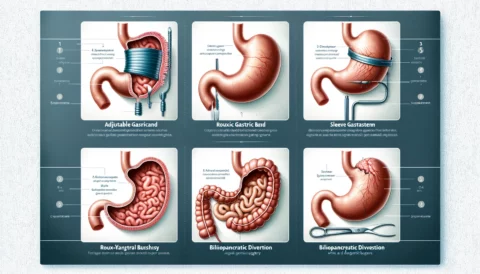Many people who are considering bariatric surgery have heard of both lap band and gastric sleeve procedures. Both types of surgery are designed to help people with severe obesity to lose weight. The main differences between these two types of bariatric surgery are how they work and the risks associated with them. Lap band surgery is a less invasive procedure, while gastric sleeve is a more invasive procedure. This article will discuss the differences between lap band and gastric sleeve, including the risks, benefits, and recovery time associated with each.
Lap Band vs. Gastric Sleeve: Comparing the Pros and Cons of Each Bariatric Surgery Option
Bariatric surgery is a major decision that should not be taken lightly, as there are potential risks and benefits associated with each type. Lap Band and Gastric Sleeve are two of the most common types of bariatric surgeries. This article will provide an overview of the advantages and disadvantages of each procedure, to help individuals make an informed decision.
Lap Band Surgery:
Pros: Lap Band surgery is minimally invasive, as it is performed laparoscopically. This means that the surgery requires only small incisions, with shorter recovery time and minimal scarring. The Lap Band is adjustable and reversible, allowing for a greater degree of control over the patient’s diet.
Cons: Lap Band surgery has a higher rate of complications and requires regular follow-up visits with a doctor. In addition, the Lap Band is not always successful in achieving long-term weight loss goals.
Gastric Sleeve Surgery:
Pros: Gastric Sleeve surgery is a more permanent solution than the Lap Band and typically results in significant weight loss in a shorter period of time. This surgery is also not reversible, which may be beneficial for individuals who are more likely to adhere to the required diet and lifestyle changes.
Cons: Gastric Sleeve surgery is more invasive than the Lap Band, as it requires a larger incision. This procedure also carries risks of complications, such as infection and bleeding. Additionally, the surgery is not adjustable, so if the patient’s weight loss stalls, there is no way to adjust the surgery to further promote weight loss.
When considering bariatric surgery, it is important to weigh the pros and cons of each type of procedure to determine the best option for your individual needs. Surgery is a major decision and should not be taken lightly. It is recommended to consult with a physician to discuss which type of bariatric surgery is right for you.
Lap Band vs. Gastric Sleeve: Examining the Differences in Post-Surgery Care and Recovery Times
The Lap Band and gastric sleeve procedures are two of the most popular bariatric surgeries available to those looking to reduce their weight. Both surgeries offer the potential of significant and long-term weight loss, but the post-surgery care and recovery times associated with each vary. By understanding the differences between the Lap Band and gastric sleeve procedures, patients can make an informed decision about the best surgery for their individual needs.
One key difference between the Lap Band and gastric sleeve is the post-surgery care needed. Lap Band surgery is considered a minimally invasive procedure, meaning that the recovery time is usually short and there is minimal need for post-surgery care. Patients typically experience minimal pain and can resume normal activities within one to two weeks. In contrast, gastric sleeve surgery is a more involved procedure that requires more post-surgery care and a longer recovery time. Gastric sleeve patients usually experience more pain and need to take more precautions to ensure a full recovery. They are typically advised to take two to four weeks off from work and normal activities, and they may need to take additional medications to manage their pain and discomfort.
The other main difference between the Lap Band and gastric sleeve is the recovery time. Lap Band surgery typically requires a shorter recovery time, with most patients able to return to regular activities within a few days. In contrast, gastric sleeve surgery requires a longer recovery time, with most patients taking two to four weeks off from work and normal activities. This longer recovery time is due to the more invasive nature of the gastric sleeve procedure, as well as the need to heal from the incisions made during the procedure.
Although Lap Band and gastric sleeve surgery both offer the potential for significant and long-term weight loss, the post-surgery care and recovery times associated with each are very different. Patients should carefully consider these differences before making a decision about which surgery is best for them. With the right information and guidance, patients can make an informed choice about the procedure that will give them the best chance for long-term success.
Conclusion
The lap band and gastric sleeve surgeries are both effective treatments for severe obesity but there are some key differences between them. The lap band is a reversible procedure that requires ongoing adjustments over time, while the gastric sleeve is a permanent procedure with fewer risks and complications. Ultimately, the best surgical option for a patient depends on their individual circumstances. The best way to determine which procedure is right for you is to discuss your options with a qualified medical professional.






